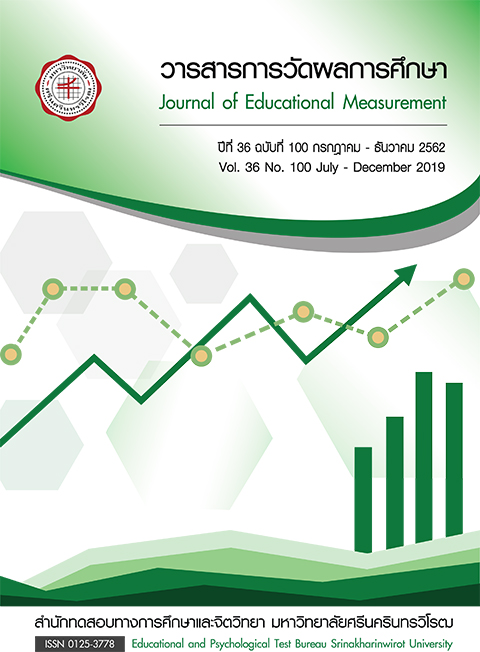Construction of online game addiction behavior among upper secondary school students in schools in the bangkok archdiocese
Keywords:
Online game addiction behavior, Schools in the Bangkok Archdiocese, NormsAbstract
The purposes of this research were to construct and identify quality or measuring tools for online game addiction behavior among upper secondary school students in schools in the Bangkok Archdiocese. The sample groups in the research came from multi-stage random sampling and aspect divided into three groups. The first group of three hundred and seventy-five students analyzed the quality control of the test. The second group of three hundred and seventy-five students was for checking the construct validity of the test. The third group of three hundred and seventy-five students was for the creation of the norms of the test. The created test consisted of situational multiple-choice questions with four choices, aiming to measure online game addiction behavior among upper secondary school students in schools in the Bangkok Archdiocese. The research results found the following: 1) the twenty-one question online game addiction behavior test had an IOC of 0.60-1.00 and an item discrimination of 0.486-0.836 and reliability at 0.852; 2) after checking the construct validity of the test by second-order confirmatory factor analysis, which found that the model of the online game addiction behavior test created by the researcher conformed with the empirical data. ( = 188.213, df= 175, p= 0.234, GFI = 0.954, AGFI = 0.940, RMSEA = 0.014, SRMR = 0.409) This means that the twenty-one questions were used to test four aspects of behavior, which were time consumption, desire to play, emotional and behavioral control, and interaction with others, were accurate; and 3) the norms for score interpretation were classified according to a T-score, where students with higher levels of online game addiction had a T-score of 57 or higher.
References
ชุตินาถ ศักรินทร์กุล และอลิสา วัชรสินธุ. (2556). ร้อยละและปัจจัยด้านจิตสังคมที่เกี่ยวข้องกับการข่มเหงรังแกในเด็กนักเรียนมัธยมต้น เขตอำเภอเมือง จังหวัดเชียงใหม่. วารสารสมาคมจิตแพทย์แห่งประเทศไทย, 59(3), 221-230.
ชยานันท์ โคสวรรณ์ สุนทร คำนวล และธัญญรัศม์ ทองคำ. (2560). การพัฒนาเครื่องมือประเมินผลการเรียนรู้โดยใช้ปัญหาเป็นฐาน. วารสารการวัดผลการศึกษา, 34(2), 30-44.
ธิดารัตน์ ปุรณะชัยคีรี, สิรินัดดา ปัญญาภาส และฐิตวี แก้วพรสวรรค์. (2558). กลยุทธในการแก้ปัญหาการถูกรังแกของเด็กนักเรียนระดับชั้นประถมศึกษาตอนปลาย. วารสารสมาคมจิตแพทย์แห่งประเทศไทย, 60(4): 275-286.
วีณา มิ่งเมือง. (2540). ผลของการปรึกษาเชิงจิตวิทยาแบบกลุ่มตามแนวคิด พิจารณาความเป็นจริงต่อกลวิธีการเผชิญปัญหาของนักเรียนชั้นมัธยมศึกษาปีที่ 3 ที่มีผลสัมฤทธิ์ทางการเรียนต่ำ. (วิทยานิพนธ์ปริญญามหาบัณฑิต). กรุงเทพฯ: จุฬาลงกรณ์มหาวิทยาลัย คณะจิตวิทยา สาขาวิชาจิตวิทยาการปรึกษา.
ศุภรัตน์ เอกอัศวิน และจอมสุรางค์ โพธิสัตย์. (2560) ร้อยละของประสบการณ์รังแกและโรคร่วมจิตเวชในนักเรียนไทย. วารสารสุขภาพจิตแห่งประเทศไทย, 25(2), 96-106.
สมบัติ ตาปัญญา. (2549). รายงานการสำรวจปัญหาการรังแกกันของนักเรียน. เชียงใหม่: คณะแพทยศาสตร์ มหาวิทยาลัยเชียงใหม่.
สวพร มากคุณ, ดลดาว ปูรณานนท์ และเพ็ญนภา กุลนภาดล. (2561). ผลการปรึกษากลุ่มทฤษฎียึดบุคคลเป็นศูนย์กลางต่อการให้อภัยของนักเรียนอาชีวศึกษา. วารสารการวัดผลการศึกษา, 35(2), 54-67.
Andreou, E. (2001). Bully/victim problems and their association with coping behaviour in conflictual peer interactions among school-age children. Educational Psychology, 21(1), 59-66.
Bijttebier, P., & Vertommen, H. (1998). Coping with peer arguments in school‐age children with bully/victim problems. British Journal of Educational Psychology, 68(3), 387-394.
Braun-Lewensohn, O., Alziadana, S., & Eisha, H. (2015). Coping resources and extra-curricular activity as explanatory factors of exposure to violence: Comparing Jewish and Arab youth in Israel. The journal of primary prevention, 36(3), 167-176.
Frydenberg, E. (1997). Adolescent coping: Theoretical and research perspectives. Psychology Press.
Gaffney, H., Farrington, D. P., & Ttofi, M. M. (2019). Examining the Effectiveness of School-Bullying Intervention Programs Globally: a Meta-analysis. International Journal of Bullying Prevention, 1(1), 14-31.
Khamis, V. (2015). Bullying among school-age children in the greater Beirut area: Risk and protective factors. Child abuse & neglect, 39, 137-146.
Kodish, T., Herres, J., Shearer, A., Atte, T., Fein, J., & Diamond, G. (2016). Bullying, depression, and suicide risk in a pediatric primary care sample. Crisis.
Lazarus, R. S., & Folkman, S. (1984). Coping and adaptation. The handbook of behavioral medicine, 282325.
Olweus, D. (1996). The revised Olweus bully/victim questionnaire. University of Bergen, Research Center for Health Promotion.
Vaillancourt, T., Trinh, V., McDougall, P., Duku, E., Cunningham, L., Cunningham, C., ...
& Short, K. (2010). Optimizing population screening of bullying in school-aged
children. Journal of School Violence, 9(3), 233-250.
Völlink, T., Bolman, C. A., Dehue, F., & Jacobs, N. C. (2013). Coping with cyberbullying: Differences between victims, bully‐victims and children not involved in bullying. Journal of community & applied social psychology, 23(1), 7-24.



